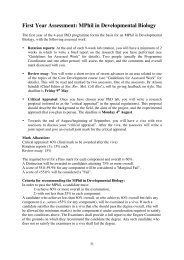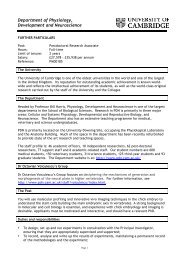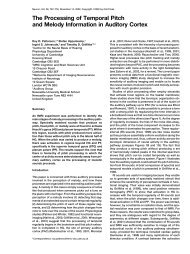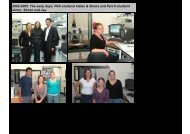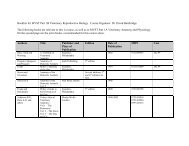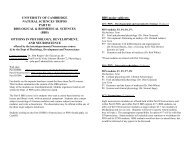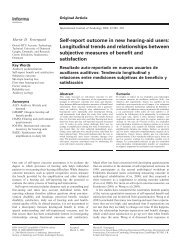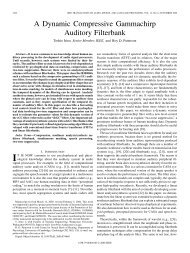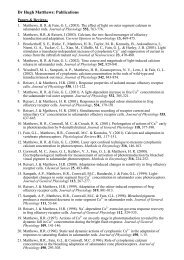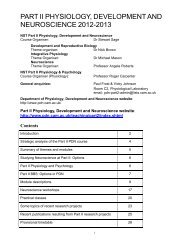FRIDAY MORNING, 20 MAY 2005 REGENCY E, 8:30 A.M. TO 12:00 ...
FRIDAY MORNING, 20 MAY 2005 REGENCY E, 8:30 A.M. TO 12:00 ...
FRIDAY MORNING, 20 MAY 2005 REGENCY E, 8:30 A.M. TO 12:00 ...
You also want an ePaper? Increase the reach of your titles
YUMPU automatically turns print PDFs into web optimized ePapers that Google loves.
5aPP24. Utilizing different channels for multiple inputs in cochlear<br />
implant processing. Bom Jun Kwon Cochlear Americas, 4<strong>00</strong><br />
Inverness Pkwy, Ste. 4<strong>00</strong>, Englewood, CO 801<strong>12</strong>, bjkwon@gmail.com<br />
While cochlear implants successfully provide auditory sensation for<br />
deaf people, speech understanding through the device is compromised<br />
when there is a background noise or competing sounds, partly due to<br />
implant users’ reduced ability in auditory grouping. The present study<br />
investigates whether providing multiple streams of input on different channels<br />
would facilitate auditory grouping, thereby assisting speech understanding<br />
in competing sounds. In acoustic hearing, presenting two streams<br />
of input such as speech and noise in spectrally separate channels generally<br />
facilitates grouping; however, in electric hearing it is difficult to predict<br />
and separating them could lead to a negative result, because channel<br />
interactions inferred from the excitation patterns are severe and the actual<br />
amount of electric current for the noise delivered to the cochlea would be<br />
much higher for a given SNR, therefore contaminating the target more<br />
effectively. Results from consonant identification measured in a variety of<br />
speech/noise conditions same/different channels indicate that speech understanding<br />
generally improves with separate channels, implying that implant<br />
users appear to extract speech information on the basis of spatial<br />
channel separation, easily overcoming the distracter from the adjacent<br />
channels with higher intensity. This also proposes a new measure of channel<br />
interactions based on auditory grouping.<br />
<strong>FRIDAY</strong> <strong>MORNING</strong>, <strong>20</strong> <strong>MAY</strong> <strong>20</strong>05<br />
PLAZA B, 9:<strong>00</strong> A.M. <strong>TO</strong> <strong>12</strong>:<strong>00</strong> NOON<br />
Session 5aSA<br />
Structural Acoustics and Vibration: General Vibration: Modeling, Propagation, Dissipation and Control<br />
Linda P. Franzoni, Chair<br />
Dept. of Mechanical Engineering and Material Science, Duke Univ., Durham, NC 27708-0<strong>30</strong>0<br />
Contributed Papers<br />
9:<strong>00</strong><br />
5aSA1. Time reversal in heterogeneous flexural beams. Dany<br />
Francoeur and Alain Berry Dept. Gen. Mecanique, Universite de<br />
Sherbrooke, 25<strong>00</strong> boul. de l’Universite, Sherbrooke, QC, Canada J1K 2R1,<br />
Alain.Berry@USherbrooke.ca<br />
Time reversal of acoustic and structure-borne waves has been explored<br />
in recent years mostly for ultrasound and for nondispersive propagation,<br />
that is under frequency-independent wave velocity. In contrast, the case of<br />
time reversal in flexural beams presented here involves dispersive propagation,<br />
and is carried for frequencies below 5 kHz. The study has been<br />
started with analytical time reversal simulations in infinite homogeneous<br />
or heterogeneous beams comprising point-mass scatterers. Experiments<br />
have also been realized on a5mbeam with anechoic terminations and<br />
under transverse impact excitation. The time-reversal mirror was made of<br />
several thin piezoceramic elements bonded on the beam to sense the impulse<br />
response of the structure and re-emit its time-reversed image. The<br />
experimental results are in good agreement with the analytical results, and<br />
show that time spreading due to dispersive propagation of bending waves<br />
is successfully compensated by the time reversal operation. The presentation<br />
will illustrate the main results of the simulations and a comparison<br />
with the experiments.<br />
9:15<br />
5aSA2. Medium frequency vibration modeling of cracked plates using<br />
hierarchical trigonometric functions. Jérôme Pinsonnault, Patrice<br />
Masson, Philippe Micheau GAUS, Mech. Eng. Dept., Université de<br />
Sherbrooke, Sherbrooke, QC, Canada J1K 2R1,<br />
Patrice.Masson@USherbrooke.ca, and Nezih Mrad Defence R&D<br />
Canada, Dept. of Natl. Defence, Ottawa, ON, Canada K1A 0K2<br />
A modeling tool is proposed to describe the vibration behavior of<br />
pristine and damaged plates in the medium frequency range below 10<br />
kHz. This tool is intended to provide a platform for the development and<br />
assessment of damage detection algorithms for aircraft structural health<br />
monitoring applications. The proposed analytical model employs a Hierarchical<br />
Trigonometric Function Set HTFS to characterize homogeneous<br />
plates with through cracks. This approach takes advantage of the very high<br />
order of stability of the HTFS O. Beslin and J. Nicolas, J. Sound Vib.<br />
<strong>20</strong>2, 633–655 1997 to approximate the effects of a small crack in a<br />
plate for all combinations of classical boundary conditions e.g., CFSC,<br />
CCFF, FSFS. The model is first presented and then assessed for healthy<br />
and cracked CCCC plates with eigenvalues and eigenmodes presented in<br />
the literature. For a healthy square plate, numerical results provide good<br />
agreement up to the 1<strong>00</strong>0th mode while, for a cracked rectangular plate,<br />
good agreement is obtained up to the 3rd mode, corresponding to the<br />
highest mode order available in the literature. Wave propagation simulation<br />
obtained from HTFS shows the scattering around the cracks in the<br />
plates. Experimental validation of the model is conducted both in frequency<br />
and time domains for healthy and cracked plates. Work supported<br />
by the Consortium for Research and Innovation in Aerospace in Quebec<br />
CRIAQ and Defence R&D Canada.<br />
9:<strong>30</strong><br />
5aSA3. An exact analytical expression of the shear coefficient in the<br />
Mindlin plate equation. Andrew Hull Code 82<strong>12</strong>, Naval Undersea<br />
Warfare Ctr., Newport, RI 02841, hullaj@npt.nuwc.navy.mil<br />
This paper derives an exact analytical expression of the shear coefficient<br />
in the Mindlin plate equation for a plate of infinite extent. The equation<br />
of motion derived from the Mindlin plate equation is set equal to the<br />
equation of motion derived from the thick plate equation, and the result is<br />
a closed-form expression of the shear coefficient at all wave numbers and<br />
frequencies. A numerical example is included to illustrate the variation of<br />
the shear coefficient. It is shown that the shear coefficient is extremely<br />
dependent on wave number and only slightly dependent on frequency.<br />
Shear coefficients derived in other work are compared favorably to the<br />
values calculated by this new method at the plate flexural wave response.<br />
Work funded by the Office of Naval Research.<br />
9:45<br />
5aSA4. Structural acoustic control of plates with variable boundary<br />
conditions. Robert L. Clark, Joseph D. Sprofera Dept. of Mech. Eng.<br />
and Mater. Sci., Duke Univ., Box 90<strong>30</strong>0, Durham, NC 27708-0<strong>30</strong>0, Gary<br />
P. Gibbs, and Ran H. Cabell NASA Langley Res. Ctr., Structural Acoust.<br />
Branch<br />
A method for optimizing a structural acoustic control system with<br />
respect to potential variations in plate boundary conditions is provided.<br />
The assumed modes method is used to build a plate model with varying<br />
levels of rotational boundary stiffness to span a range of possible boundary<br />
conditions which can be used to capture uncertainty in the model. A trans-<br />
5a FRI. AM<br />
2601 J. Acoust. Soc. Am., Vol. 117, No. 4, Pt. 2, April <strong>20</strong>05 149th Meeting: Acoustical Society of America 2601



